Saint-Gobain Bundle
How Does Saint-Gobain Dominate Its Market?
Saint-Gobain, a titan in the construction and industrial materials sectors, has a rich history dating back to 1665, evolving from a royal mirror manufacturer to a global leader. This French multinational corporation has consistently adapted, boasting a diverse portfolio and a strong presence across 76 countries. Understanding the Saint-Gobain SWOT Analysis is crucial to grasp its competitive edge.
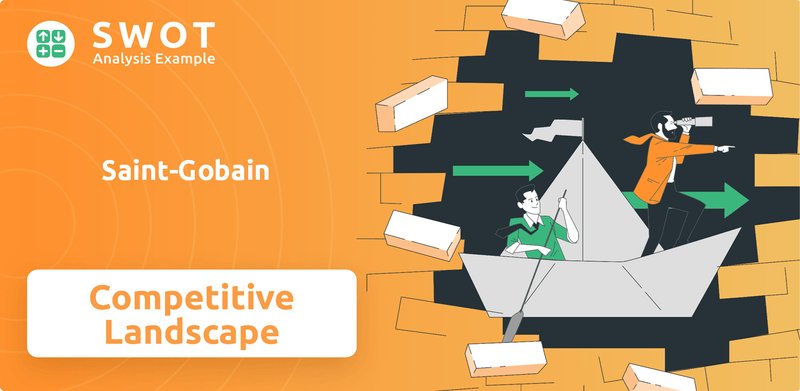
This exploration of the Saint-Gobain competitive landscape will dissect its key rivals and market dynamics. We'll delve into Saint-Gobain's business strategy, examining its competitive advantages and how its financial performance stacks up against its competitors. Furthermore, we'll analyze Saint-Gobain's market share comparison and evaluate its strategic positioning within the industry, considering both current challenges and future market outlook for Saint-Gobain.
Where Does Saint-Gobain’ Stand in the Current Market?
Saint-Gobain holds a robust market position as a worldwide leader in light and sustainable construction. Its diversified portfolio encompasses the production and retail of construction materials, along with glass, ceramics, plastics, and abrasives. This broad scope allows the company to serve various segments within the construction and industrial sectors, contributing to its strong competitive landscape.
The company's financial performance underscores its market strength. In fiscal year 2024, Saint-Gobain generated revenue of €46.517 billion and a net income of €2.844 billion. Furthermore, the company achieved a record operating margin of 11.4% in 2024, and anticipates exceeding 11.0% in 2025, exceeding its initial strategic plan objectives. This indicates effective operational management and a strong ability to generate profits.
Saint-Gobain operates in 76 countries, with a significant global footprint. This extensive presence allows the company to tap into diverse markets and mitigate risks associated with regional economic fluctuations. The company's geographic diversification is a key element of its business strategy.
Strategic acquisitions have significantly expanded Saint-Gobain's market presence. The company's acquisitions in 2024, including CSR, Bailey, OVNIVER, and FOSROC, are expected to add 3% to sales and €200 million to operating profit in 2025. These moves enhance its competitive positioning.
Saint-Gobain is the #1 building materials company in India, demonstrating its market leadership in key regions. This strong market share in a high-growth market like India highlights the company's ability to capitalize on emerging opportunities and maintain a competitive edge. This is a key factor in the company's success.
Over 50% of Saint-Gobain's sales in North America come from the renovation market. This exposure to the renovation sector provides a stable revenue stream and reduces dependence on new construction cycles. This segment is a key driver of its financial results.
Saint-Gobain's regional performance varies, with North America and Asia-Pacific being particularly strong. In the first half of 2024, these regions delivered record margins of 18% and 12.6% respectively. The company is investing in these regions to expand capacity and capitalize on growth opportunities. For a deeper understanding of the company's focus, explore the Target Market of Saint-Gobain.
- North America represents the largest region in terms of operating income.
- India is a consistent growth driver within the Asia-Pacific region.
- The company is increasing capacity for various products in North America.
- Recent acquisitions have strengthened its presence in construction chemicals.
Saint-Gobain SWOT Analysis
- Complete SWOT Breakdown
- Fully Customizable
- Editable in Excel & Word
- Professional Formatting
- Investor-Ready Format
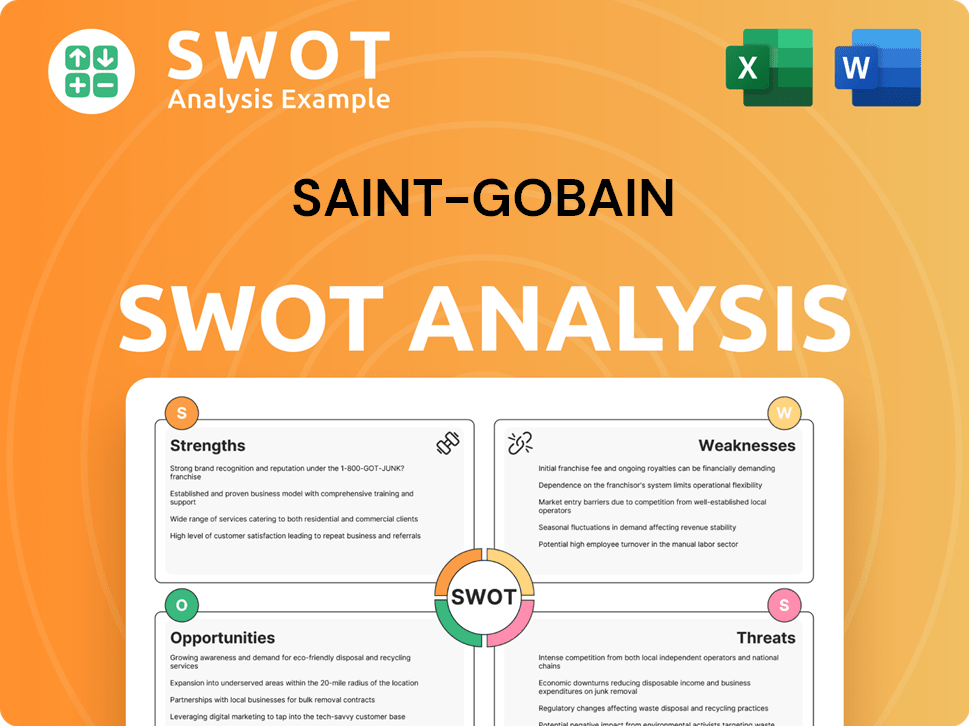
Who Are the Main Competitors Challenging Saint-Gobain?
The Growth Strategy of Saint-Gobain is significantly shaped by its competitive environment. The company operates within a fragmented market, facing both direct and indirect rivals across its diverse product lines and geographic markets. Understanding the Saint-Gobain competitive landscape is crucial for investors and stakeholders.
This competitive landscape includes major global players in construction materials and high-performance solutions. The company's strategies, including its recent acquisitions and focus on innovation, are directly influenced by the need to maintain and enhance its market position. A thorough Saint-Gobain market analysis reveals the dynamics at play.
One of the main competitors in the broader French infrastructure and construction materials sector is Vinci. Other notable competitors in the construction chemicals market include companies like Sika, a Swiss construction chemicals maker. These companies, among others, challenge Saint-Gobain through various avenues, impacting its Saint-Gobain industry position.
Companies compete on the cost-effectiveness and innovative features of their products. Saint-Gobain's focus on sustainable solutions and high-value-added offerings helps differentiate it.
Many competitors, like Saint-Gobain, have strong regional footholds. Saint-Gobain's strategy of deepening its local model and granting country CEOs increased responsibilities, effective July 1, 2025, is a direct response to the need for local adaptation and market penetration.
Competitors often offer a wide range of products, similar to Saint-Gobain's comprehensive portfolio, to cater to various construction and industrial needs.
The industry sees ongoing consolidation, with mergers and acquisitions impacting competitive dynamics. Saint-Gobain itself has been highly active in this space, with a €5 billion acquisition spree in 2024, including companies like CSR, Bailey, OVNIVER (Cemix), and FOSROC. These moves not only expand Saint-Gobain's market reach but also intensify competition for other players.
New and emerging players, particularly those focused on sustainable or digital construction solutions, are also disrupting the traditional competitive landscape. Saint-Gobain's venture business, Circular Economy Solutions (CES), and its investments in startups aligned with sustainability and innovation, such as Renovate Robotics and Fortera, demonstrate its proactive approach to these disruptions.
The company faces various competitive threats, including price pressures, the need for continuous innovation, and the challenge of adapting to changing market demands. The competitive landscape is dynamic, requiring constant strategic adjustments.
To maintain a competitive edge, Saint-Gobain focuses on several key strategies. These include leveraging its global presence, investing in research and development, and expanding its product portfolio through acquisitions. Understanding these strategies is essential for a comprehensive Saint-Gobain key competitors analysis.
- Innovation: Investing in new technologies and sustainable products.
- Geographic Expansion: Strengthening its presence in key markets.
- Strategic Acquisitions: Expanding its product offerings and market reach.
- Sustainability: Focusing on eco-friendly solutions to meet market demands.
Saint-Gobain PESTLE Analysis
- Covers All 6 PESTLE Categories
- No Research Needed – Save Hours of Work
- Built by Experts, Trusted by Consultants
- Instant Download, Ready to Use
- 100% Editable, Fully Customizable
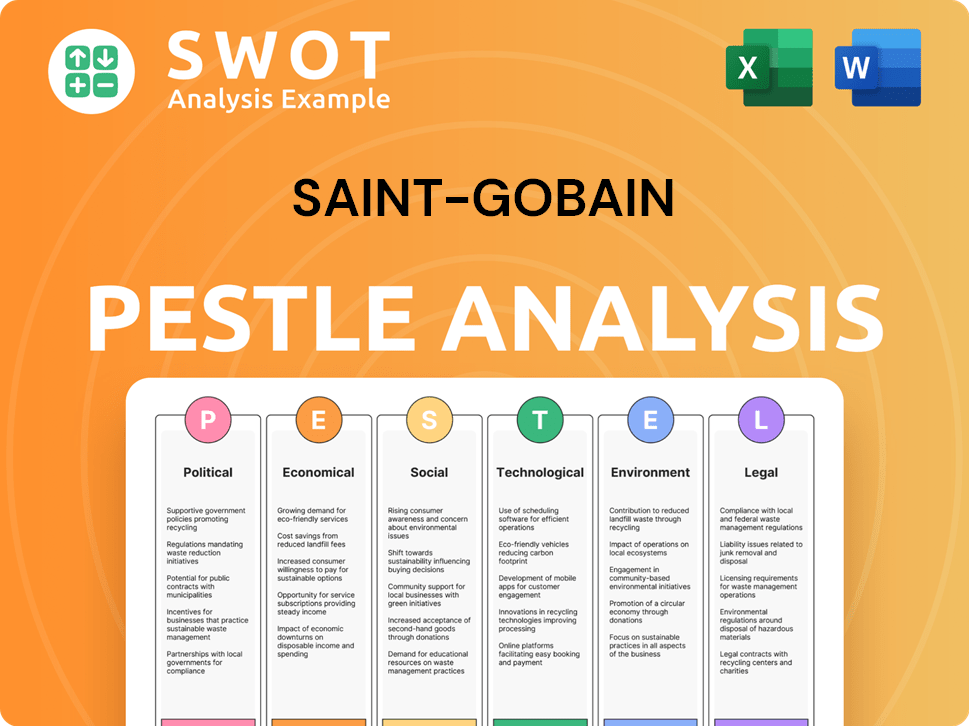
What Gives Saint-Gobain a Competitive Edge Over Its Rivals?
Understanding the Growth Strategy of Saint-Gobain is crucial for assessing its competitive standing. The company's strategic moves, including a strong focus on innovation and sustainability, have significantly shaped its market position. A deep dive into Saint-Gobain's competitive advantages reveals a multifaceted approach that combines a broad product portfolio with a robust global presence.
The Saint-Gobain competitive landscape is defined by its capacity to adapt to changing market dynamics and capitalize on growth opportunities. Its commitment to strategic acquisitions and a disciplined financial approach further strengthens its position. This analysis will explore the key elements that contribute to Saint-Gobain's competitive edge, highlighting its strengths and strategic initiatives.
Saint-Gobain's competitive advantages are rooted in its extensive history, global reach, and a forward-looking strategy focused on innovation and sustainability. These elements work in concert to provide a strong foundation for sustained growth and market leadership. This includes a diversified product portfolio, geographic diversification, innovation in R&D, strategic acquisitions, and strong financial performance.
Saint-Gobain's wide-ranging product portfolio, including materials for construction, mobility, and healthcare, gives it a significant advantage. This diversification allows the company to offer comprehensive solutions, increasing its 'share of wallet' with customers. The broad scope of products, from flat glass to insulation, provides a competitive edge in various markets.
With operations in 76 countries, Saint-Gobain benefits from a strong local presence, allowing it to adapt quickly to diverse market environments. This decentralized structure, with local CEOs, minimizes exposure to tariffs and optimizes local value chains. The Americas and Asia-Pacific regions contribute significantly to the Group's operating income.
Innovation is central to Saint-Gobain's strategy, with over 450 patents filed in 2024. The company focuses on developing innovative and sustainable solutions to meet market needs, with one in four products sold not existing five years ago. This commitment to eco-innovation, including its net-zero carbon by 2050 pledge, provides a significant competitive advantage.
Strategic acquisitions have been pivotal in reinforcing Saint-Gobain's profitable growth profile. The €5 billion acquisition spree in 2024, including companies like CSR, Bailey, OVNIVER (Cemix), and FOSROC, has expanded its footprint in high-growth markets. These acquisitions have transformed Saint-Gobain into a worldwide leader in construction chemicals, with combined sales of €6.5 billion (pro forma) across 76 countries.
Saint-Gobain's financial performance underscores its sustainability, with a record operating margin of 11.4% in 2024 and expectations of over 11.0% in 2025. Its robust balance sheet, with a net-debt-to-EBITDA ratio of 1.4x at the end of June 2024, enables continued strategic M&A and shareholder returns. The company's consistent generation of free cash flow, with a 62% cash conversion ratio in 2024, further solidifies its competitive position.
- Record operating margin of 11.4% in 2024.
- Net-debt-to-EBITDA ratio of 1.4x as of June 2024.
- Cash conversion ratio of 62% in 2024.
- €5 billion acquisition spree in 2024.
Saint-Gobain Business Model Canvas
- Complete 9-Block Business Model Canvas
- Effortlessly Communicate Your Business Strategy
- Investor-Ready BMC Format
- 100% Editable and Customizable
- Clear and Structured Layout
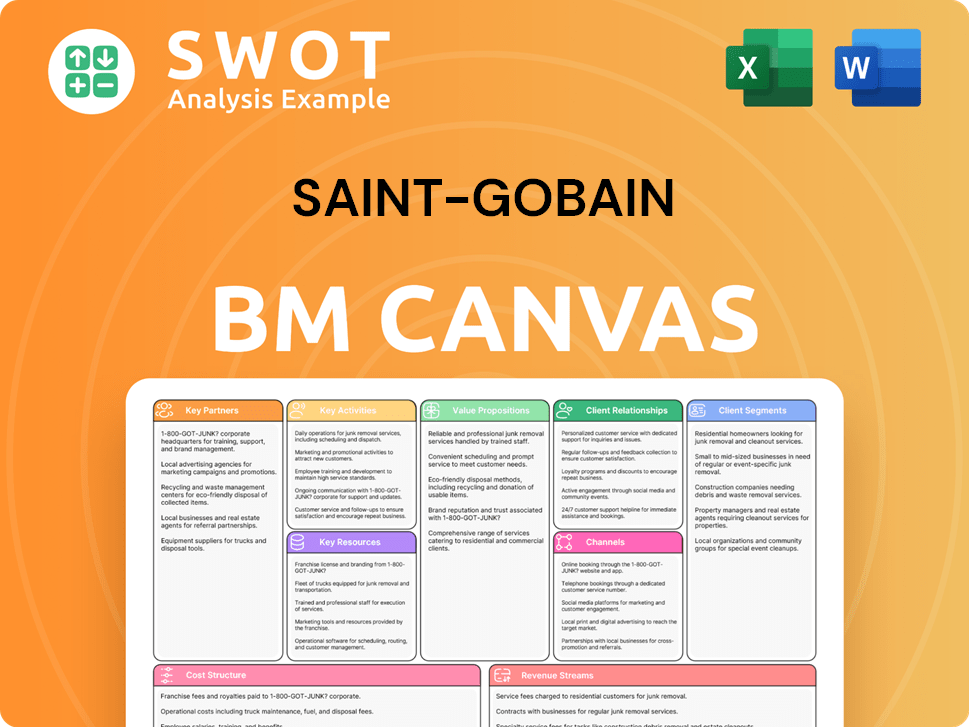
What Industry Trends Are Reshaping Saint-Gobain’s Competitive Landscape?
The competitive landscape for Saint-Gobain, a key player in the building materials sector, is shaped by industry trends, challenges, and opportunities. The company's strategic positioning is critical for navigating market dynamics and ensuring sustained growth. Understanding the Saint-Gobain competitive landscape involves analyzing its position relative to its competitors, its business strategy, and its ability to adapt to market changes.
Saint-Gobain's industry position is influenced by its commitment to sustainability, technological advancements, and its global presence. Risks include macroeconomic uncertainties and geopolitical tensions, while opportunities arise from urbanization and demographic shifts. A comprehensive Saint-Gobain market analysis reveals its strengths, weaknesses, opportunities, and threats, providing a clear picture of its competitive standing. For a deeper dive into the company's origins, consider reading Brief History of Saint-Gobain.
The construction industry is undergoing a significant transformation driven by sustainability and digitalization. Saint-Gobain is well-positioned to benefit from this trend through its focus on low-carbon solutions and technological innovation. The shift towards sustainable construction is creating new market opportunities for Saint-Gobain.
Macroeconomic uncertainties and geopolitical tensions pose significant challenges to the industry. Elevated interest rates and varying regional economic conditions create complexities. The company's decentralized structure helps to mitigate these risks, allowing for adaptability to local market dynamics.
Urbanization and demographic shifts, particularly in Asia and emerging markets, offer substantial growth opportunities. Saint-Gobain is expanding its presence in high-growth regions through strategic acquisitions and investments. The company's focus on profitable growth and portfolio optimization is expected to drive future success.
Saint-Gobain is focused on achieving an operating margin of over 11.0% in 2025. The company's strategy includes divesting lower-margin businesses and acquiring high-margin ones. The upcoming Capital Markets Day on October 6, 2025, will further detail the Group's future ambitions.
Saint-Gobain's competitive advantages stem from its commitment to sustainability, technological innovation, and global presence. The company's ability to adapt to macroeconomic uncertainties and capitalize on urbanization trends is crucial for its market positioning. Its strategic acquisitions and focus on profitable growth are key elements of its business strategy.
- Sustainability: Saint-Gobain aims for net-zero carbon emissions by 2050.
- Innovation: Over 450 patents were filed in 2024.
- Global Expansion: Focus on high-growth regions like India and the Middle East.
- Financial Performance: The company targets an operating margin of over 11.0% in 2025.
Saint-Gobain Porter's Five Forces Analysis
- Covers All 5 Competitive Forces in Detail
- Structured for Consultants, Students, and Founders
- 100% Editable in Microsoft Word & Excel
- Instant Digital Download – Use Immediately
- Compatible with Mac & PC – Fully Unlocked
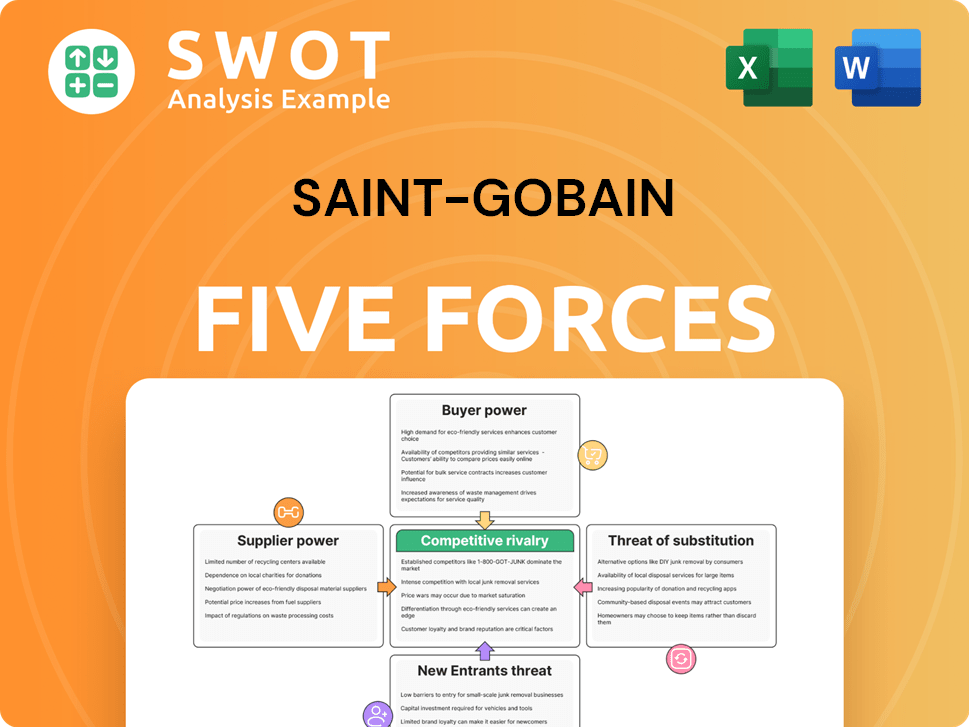
Related Blogs
- What are Mission Vision & Core Values of Saint-Gobain Company?
- What is Growth Strategy and Future Prospects of Saint-Gobain Company?
- How Does Saint-Gobain Company Work?
- What is Sales and Marketing Strategy of Saint-Gobain Company?
- What is Brief History of Saint-Gobain Company?
- Who Owns Saint-Gobain Company?
- What is Customer Demographics and Target Market of Saint-Gobain Company?
Disclaimer
All information, articles, and product details provided on this website are for general informational and educational purposes only. We do not claim any ownership over, nor do we intend to infringe upon, any trademarks, copyrights, logos, brand names, or other intellectual property mentioned or depicted on this site. Such intellectual property remains the property of its respective owners, and any references here are made solely for identification or informational purposes, without implying any affiliation, endorsement, or partnership.
We make no representations or warranties, express or implied, regarding the accuracy, completeness, or suitability of any content or products presented. Nothing on this website should be construed as legal, tax, investment, financial, medical, or other professional advice. In addition, no part of this site—including articles or product references—constitutes a solicitation, recommendation, endorsement, advertisement, or offer to buy or sell any securities, franchises, or other financial instruments, particularly in jurisdictions where such activity would be unlawful.
All content is of a general nature and may not address the specific circumstances of any individual or entity. It is not a substitute for professional advice or services. Any actions you take based on the information provided here are strictly at your own risk. You accept full responsibility for any decisions or outcomes arising from your use of this website and agree to release us from any liability in connection with your use of, or reliance upon, the content or products found herein.